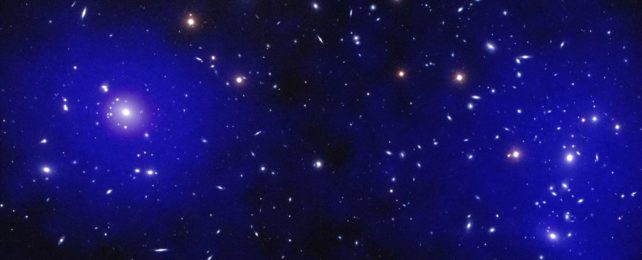A collision between some of the largest structures in space has just given us a clue about one of the biggest mysteries in the Universe: the location of a whole pile of missing matter.
In the galaxy cluster Abell 98 – in which two sub-clusters are in the process of merging – scientists have found a filament of gas consistent with something called the warm-hot intergalactic medium (WHIM).
This fog of plasma thought to float around in between galaxies happens to be one of the leading candidates for the location of a shortfall in the amount of visible, garden-variety particles called 'baryonic matter' measured in the local Universe.
Previous evidence suggests that the WHIM is out there, but it's proven difficult to locate enough of the material to argue how it contributes to the missing baryons.
"Finding these filaments of missing matter has proven to be exceptionally difficult, and only a few examples are known," says astrophysicist Arnab Sarkar of the Harvard-Smithsonian Center for Astrophysics (CfA). "We are excited that we have likely pinpointed another."
The missing matter is one of the stranger questions we have about the Universe. We know, more or less, the distribution of matter/energy throughout the cosmos. Most of it is stuff we can't detect and therefore don't even know what it is: 68 percent in the form of dark energy and 27 percent as dark matter.
The remaining 5 or so percent is baryonic matter. That's the stuff that we can detect, and from which everything we see is made: stars, planets, dust, galaxies, clouds, black holes, humans.
We know how much baryonic matter was around at the time of the Big Bang because we have radiation left over from that epoch, the Cosmic Microwave Background (CMB), that scientists have been able to decode.
When scientists started to take stock of the baryonic matter that's immediately around us today, however, the numbers didn't add up. There's a lot missing, between half and a third of what has been predicted based on the CMB.
One possible location for this is the WHIM; filaments of gas with temperatures between 10,000 and 10 million Kelvin, in which baryons are shock-heated and compressed. However, locating these tenuous structures in the space between much brighter galaxies has been tricky.
Enter Abell 98, a cluster of galaxies around 1.4 billion light-years away. X-ray observations of Abell 98 have revealed hot gas structures between two sub-clusters. Earlier this year, Sarkar and his colleagues published an analysis finding that this filament contains a giant shock wave as the sub-clusters come together.
Their analysis also probed the properties of the filament of gas and found two distinct temperature regimes: one at 20 million Kelvin, and the second at 10 million Kelvin. The hotter gas, the researchers say, is likely the result of the gas haloes around the two sub-clusters overlapping.
The cooler gas, on the other hand, is consistent with the hotter, denser end of the theorized WHIM range, the team found.
In a second paper, a team of researchers led by astrophysicist Gabriella Alvarez of CfA has found further evidence for WHIM, not in the space between the two sub-clusters, but on the far side of the sub-cluster, far from the shock front. This, too, was consistent with denser WHIM.
"These measurements," the researchers write in the paper, "provide tantalizing evidence for the presence of a larger-scale structure, with the diffuse WHIM connecting to the cluster outskirts along cosmic filaments."
We still haven't identified enough WHIM to account for all the missing baryons. It could also be hiding in other places; evidence suggests that some may be hiding in gas filaments stretching between galaxies, or lurking as clouds of thin gas in intergalactic space.
But our tools for detecting WHIM are getting more powerful, with new-generation X-ray telescopes taking to the skies. When they peer into the voids between the stars, they should reveal even more of the secrets of deep space, and what lurks therein.
The two papers are to appear, respectively, in The Astrophysical Journal Letters and The Astrophysical Journal, and are available on arXiv. They can be found here and here.
